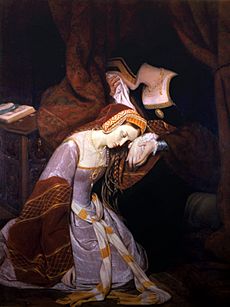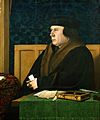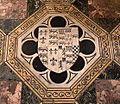Anne Boleyn facts for kids
Quick facts for kids Anne Boleyn |
|
|---|---|
| Marchioness of Pembroke | |

Late Elizabethan portrait, possibly derived from a lost original of 1533–36
|
|
| Queen consort of England | |
| Tenure | 28 May 1533 – 17 May 1536 |
| Coronation | 1 June 1533 |
| Born | c. July 1501–1507 Blickling Hall, Norfolk or Hever Castle, Kent |
| Died | 19 May 1536 (aged 28–35) Tower of London, London |
| Burial | 19 May 1536 Church of St Peter ad Vincula, Tower of London, London |
| Spouse | |
| Issue | Elizabeth I of England |
| Family | Boleyn |
| Father | Thomas Boleyn, 1st Earl of Wiltshire |
| Mother | Lady Elizabeth Howard |
| Signature |  |
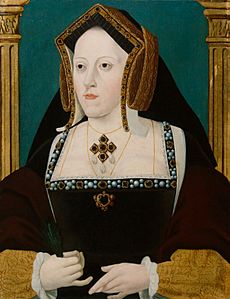
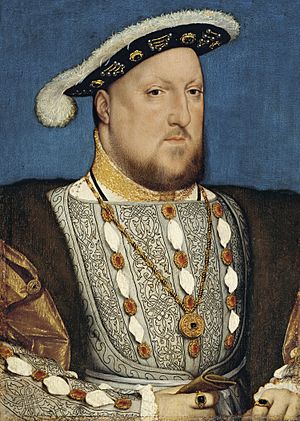
Anne Boleyn (born between 1501 and 1507 – died 19 May 1536) was the second wife of King Henry VIII of England. She was Queen of England from 1533 until 1536. Anne was also the mother of Elizabeth I of England, who later became a famous queen.
Many people believe Anne Boleyn was one of the most important queens England has ever had. Her marriage to Henry VIII caused big changes in England. It led to Henry divorcing his first wife, Catherine of Aragon. It also made England separate from the Roman Catholic Church. Sadly, Anne was later accused of serious crimes against the king and was put to death.
Contents
Who Was Anne Boleyn?
Her Personality and Looks
People had different ideas about Anne Boleyn's appearance. One famous description came from a Catholic writer named Nicholas Sanders in 1586. He wrote it many years after Anne died, so it might not be completely accurate.
Sanders described Anne as tall with dark hair and an oval face. He also mentioned a small mark under her chin, which she often hid with high-collared dresses. Despite some of these details, he said she was "handsome to look at, with a pretty mouth."
Anne was also known for being a very good dancer. A writer named William Forrest praised her "excellent skill as a dancer."
Her Early Life and Education
Anne Boleyn was born in either 1501 or 1507. Her birthplace was either Blickling Hall in Norfolk or Hever Castle in Kent. Her father was Sir Thomas Boleyn, who worked for the king and later became a diplomat. Her mother was Lady Elizabeth Howard. Anne had two siblings, a sister named Mary and a brother named George.
Like other girls from noble families, Anne received a good education. She learned subjects like arithmetic, history, reading, and writing. Her family was very religious, so she also studied the Bible.
Anne learned many useful skills for managing a household, such as embroidery and needlework. She was also very talented in music, playing instruments like the harp and lute, and she loved to sing and dance. She enjoyed games like chess and outdoor activities like horseback riding and hunting. Girls at that time were also taught to obey the men in their lives, first their father, then their husband.
In 1513, Anne went to the royal court of Margaret of Austria in the Netherlands to continue her education. There, she learned to speak French and studied art, culture, dance, literature, and poetry.
The next year, she moved to the French court. This happened when Princess Mary Tudor, King Henry VIII's younger sister, married the French King Louis XII.
Anne stayed in France even after King Louis XII died. She worked as a lady-in-waiting for Queen Claude. During this time, Anne became very good at French and learned a lot about French culture and manners. Besides English, she knew French, some Italian, and even a bit of Latin. She also became interested in fashion and new ideas about changing the Church. Anne returned to England in late 1521.
Return to England
Anne was called back to England for a possible marriage to a distant cousin, James Butler. This marriage was meant to help settle a family argument over land. However, the plan did not work out.
Instead, Anne's father found her a job at the English court. She became a lady-in-waiting to Queen Catherine, Henry VIII's first wife. While at court, Anne fell in love with Sir Henry Percy. They secretly got engaged, but their families were not happy about it.
Cardinal Wolsey, a powerful advisor to the king, ordered them to separate. Anne was sent home to Hever Castle. Henry Percy was forced to marry another woman. Anne blamed Cardinal Wolsey for ruining her love. She was determined to get revenge on him because he had called her a "foolish girl."
Royal Love Story
King Henry Falls in Love
Anne soon returned to the royal court. It wasn't long before King Henry became deeply in love with her.
King Henry's marriage to Catherine of Aragon had only given him one daughter, Princess Mary. Henry desperately wanted a son to become king after him and continue his family's rule. But Catherine was now too old to have more children. Henry began to see Anne as the answer to his problem. He decided he wanted to divorce Catherine so he could marry Anne and have a male heir.
A special court was held to decide if the divorce should be allowed, but no one could agree on what to do.
Marriage to the King
Anne became pregnant. To make sure her child would be seen as a rightful heir to the throne, Anne and Henry secretly got married on January 25, 1533. This happened even though Henry's divorce from Catherine was not yet final.
In May of that year, Henry's marriage to Catherine of Aragon was declared illegal by the new Archbishop of Canterbury, Thomas Cranmer. Catherine was sent away from court.
Now that she was recognized as Henry's legal wife, Anne was officially crowned Queen of England on June 1, 1533. She hoped to give Henry the son he wanted.
However, on September 7, 1533, Anne gave birth to a daughter, who would later become Elizabeth I of England. King Henry was very disappointed that it wasn't a son. The situation got worse when the king started paying special attention to another lady at court, named Jane Seymour.
On January 29, 1536, Anne gave birth to a baby boy who was born too soon and did not survive. Henry felt very upset and turned completely against Anne. He even accused her of tricking him.
Downfall and Execution
Henry's new secretary, Thomas Cromwell, looked for a way to get rid of Anne so Henry could marry Jane Seymour. Cromwell found people who claimed Anne had been unfaithful to the king. Anne was put on trial and found guilty of serious crimes against the king, even though she was probably innocent.
Anne was put to death on May 19, 1536, at the Tower of London, London, England. She was buried in the Chapel Royal of Saint Peter ad Vincula, inside the Tower of London.
Images for kids
-
Anne's sister Mary Boleyn
-
Claude of France, wife of Francis I. Anne served as her maid of honour for nearly seven years.
-
Catherine of Aragon, Henry's first wife and queen
-
Bishop John Fisher, by Hans Holbein the Younger. Fisher refused to recognise Henry VIII's marriage to Anne Boleyn.
-
Greenwich Palace, also known as the Palace of Placentia, after a 17th-century drawing
-
Henry's reconciliation with Anne Boleyn, by George Cruikshank, 19th century
-
Jane Seymour became Henry's third wife shortly after Anne's execution.
-
Thomas Cromwell, Anne's one-time strong ally, with whom she clashed over foreign policy and the redistribution of church wealth. Portrait by Hans Holbein the Younger, c. 1532.
-
Thomas Cranmer, who was the sole supporter of Anne in the council
-
St Mary's Church, Erwarton, Suffolk, where Boleyn's heart was allegedly buried
See also
 In Spanish: Ana Bolena para niños
In Spanish: Ana Bolena para niños


